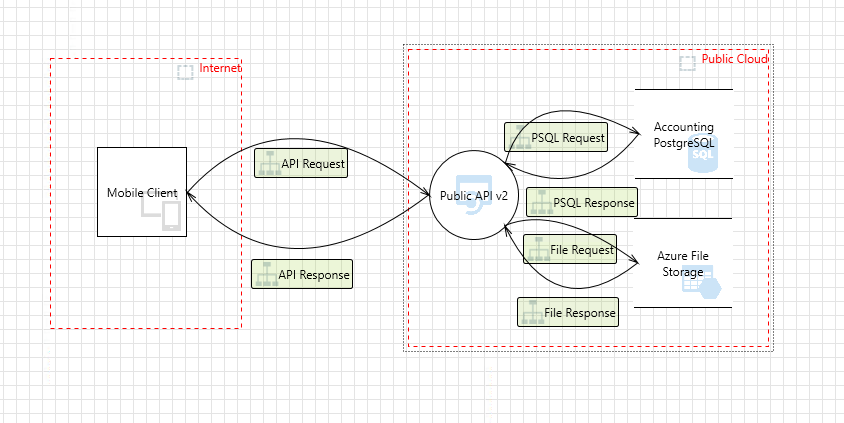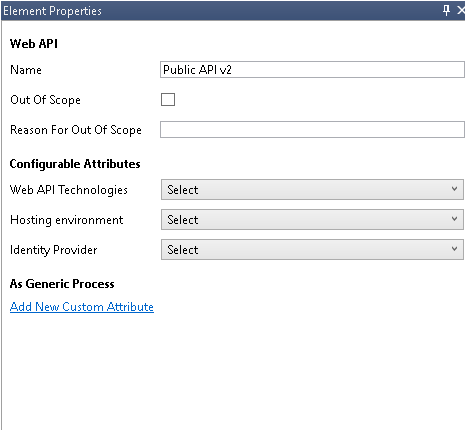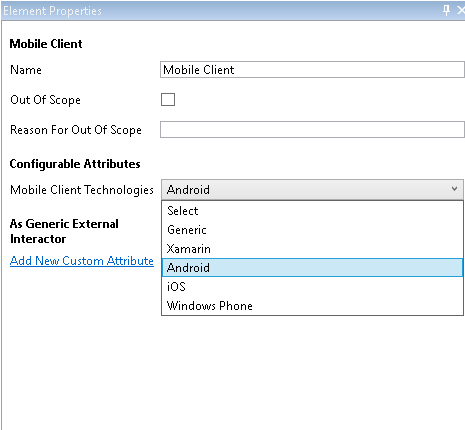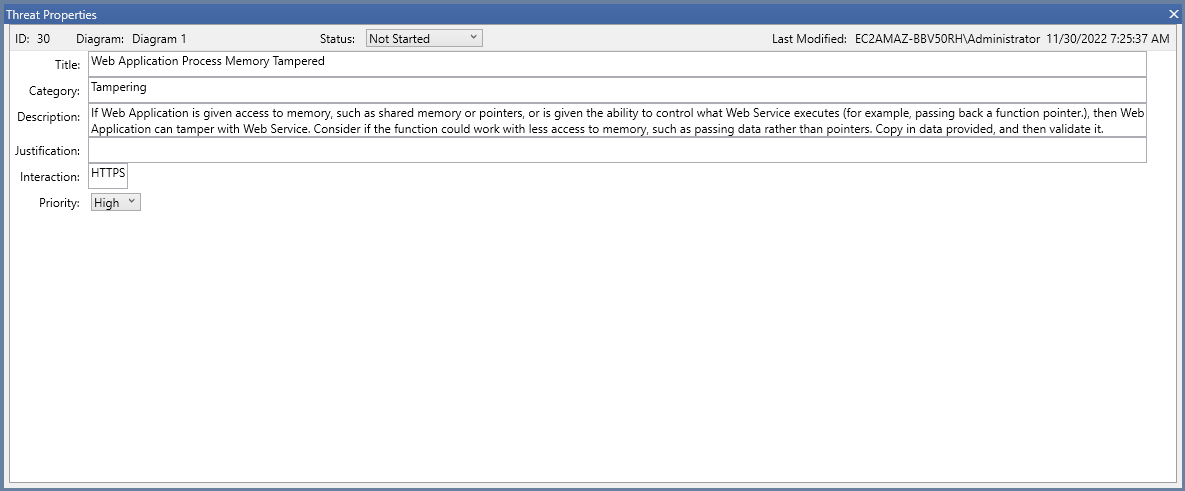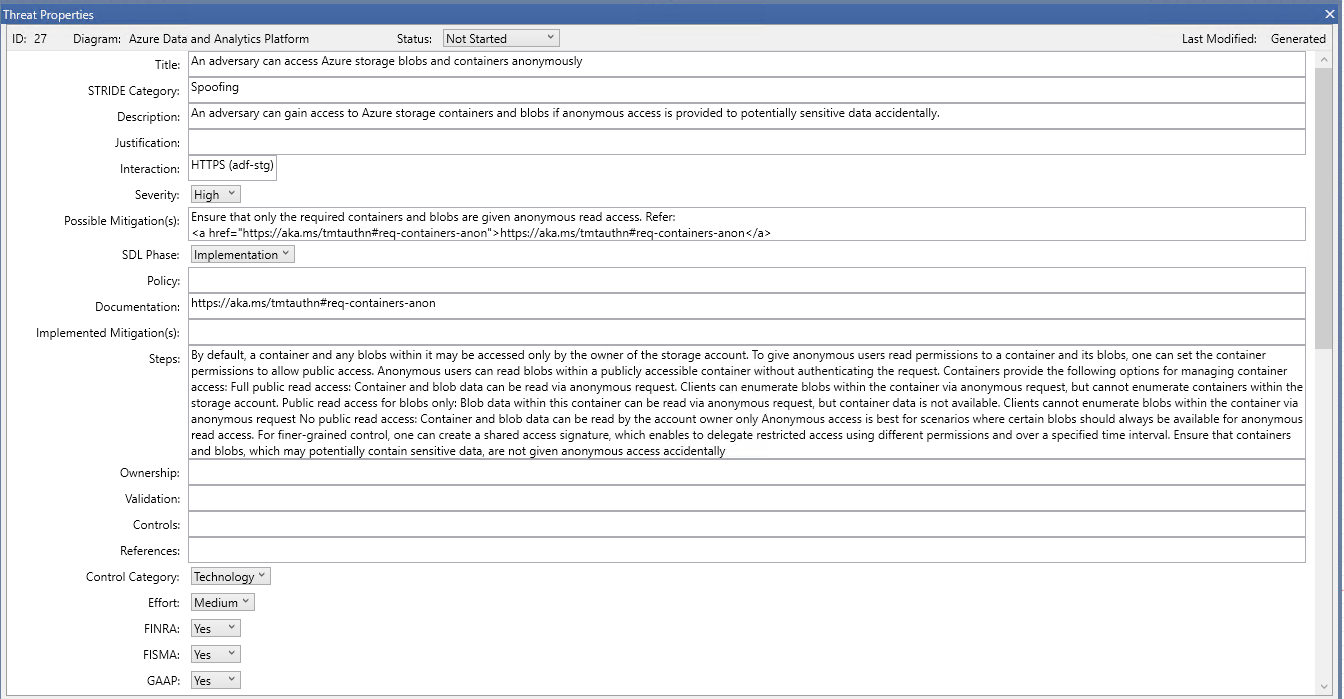MTMT mapping
This mapping configuration only applies to Microsoft Threat Model Tool Processor.
Please refer to another mapping file configuration documentation if needed. You can locate each processor's documentation in the left menu under the "StartLeft Processors (SLP)" section.
A source mapping file (or 'mapping file' for short) describe how to identify components, dataflows, TrustZones, threats and mitigations in source file and how to map them to the OTM equivalent.
Let's see how to identify the different elements:
Trustzones
For the TrustZones we need to write two fields: label and type
The label will identify the MTMT TrustZone by its MTMT type or by its name.
Let's see an example with a TrustZone in the MTMT_example.tm7:
Our Generic Trust Border Boundary TrustZone is named Internet.
We can map it by either of the two: Generic Trust Border Boundary (MTMT type) or Internet (MTMT name).
The type in the mapping file will be the type in the OTM trust zone output.
In this example, the Generic Trust Border Boundary source trust zone
will be mapped to a OTM trust zone which type will be the value of the type
in our mapping file.
In the OTM each trust zone will have a unique id and the type will be the type that we put in the mapping file
The TrustZone OTM output will be:
{"trustZones": [
{
"id": "7537441a-1c03-48c0-b9c8-f82d5906c139",
"name": "Internet",
"type": "6376d53e-6461-412b-8e04-7b3fe2b397de",
"risk": {
"trustRating": 10
},
"properties": {
"Name": "Internet"
}
}]}
In case we have two trust zones with the same MTMT type (e.g: Generic Trust Border Boundary), the OTM will have two trust zones
with the same type but different id. In the mapping file is enough having mapped once:
With two trust zones of the same type the OTM output will be:
{"trustZones": [
{
"id": "7537441a-1c03-48c0-b9c8-f82d5906c139",
"name": "Internet",
"type": "6376d53e-6461-412b-8e04-7b3fe2b397de",
"risk": {
"trustRating": 10
},
"properties": {
"Name": "Internet"
}
},
{
"id": "bd837730-6a59-11ed-a798-772dcc832e1d",
"name": "Public zone",
"type": "6376d53e-6461-412b-8e04-7b3fe2b397de",
"risk": {
"trustRating": 10
},
"properties": {
"Name": "Public zone"
}
}
]}
Due to a backward compatibility StartLeft accepts as well the legacy mapping file format. Please read Legacy-Mapping-File-Format
Components
For the components we need to write two fields: label and type.
The label will identify the MTMT component by its MTMT type. Let's see again the MTMT_example.tm7:
Our Public API v2 component is of Web API type.
So we need to put this type in the label value.
The type in the mapping file will be the type in the OTM component output.
The component OTM output will be:
{"components": [
{
"id": "5d15323e-3729-4694-87b1-181c90af5045",
"name": "Public API v2",
"type": "web-service",
"parent": {
"trustZone": "b61d6911-338d-46a8-9f39-8dcd24abfe91"
},
"properties": {
"Name": "Public API v2"
}
}]}
Public API v2.
Mobile Client Component
The Mobile Client component is a special case that needs a little customization in the mapping file.
Because from the threat modeling point of view is not the same an Android than a iOS, we need
to know which type of component is based in its Mobile Client Tecnologies property configured in
the mapping file. Let's see how to do it:
- label: Mobile Client
key: Mobile Client Technologies
values:
- value: Android
type: android-device-client
- value: iOS
type: ios-device-client
label is the component type
- The key is the property of the component where we are going to extract the value
- The values is a map to convert from the MTMT value of the property to the OTM type
Dataflows
No need to be in the mapping file. StartLeft will detect them and will fill the OTM dataflow automatically detecting the custom name, the source, and the destination.
Threats and Mitigations
No need to be in the mapping file.
StartLeft will extract OTM threats and threat instances, as well as OTM mitigations and mitigation instances from the same MTMT threat. Moreover, the OTM component to which the OTM threat instance will be added is the destination component of the MTMT threat.
Currently, Startleft maps threats and mitigations from two kinds of templates:
SDL TM Knowledge Base (Core) template
A MTMT threat
will be mapped to an OTM threat:
{
"name": "Web Application Process Memory Tampered",
"id": "30",
"categories": [
"Tampering"
],
"risk": {
"likelihood": 100,
"impact": 100
},
"description": "If Web Application is given access to memory, such as shared memory or pointers, or is given the ability to control what Web Service executes (for example, passing back a function pointer.), then Web Application can tamper with Web Service"
}
to an OTM mitigation:
{
"name": "Consider if the function could work with less access to memory, such as passing data rather than pointers",
"id": "30",
"riskReduction": 100,
"description": "Consider if the function could work with less access to memory, such as passing data rather than pointers. Copy in data provided, and then validate it"
}
and also to an OTM threat instance along with its OTM mitigation instance, which will be mapped to the corresponding OTM component:
{
"threat": "30",
"state": "AutoGenerated",
"mitigations": [
{
"mitigation": "30",
"state": "RECOMMENDED"
}
]
}
There is a special case when the MTMT threat has no ". Consider" pattern in the "Description" field. In such case, no OTM mitigation nor OTM mitigation instance will be mapped, only the OTM threat and threat instance can be mapped.
Azure Threat Model Template (AzureArchitecture) template
A MTMT threat without a "Steps" field
will be mapped to an OTM threat:
{
"name": "An adversary may read and/or tamper with the data transmitted to Azure Postgres DB due to weak configuration",
"id": "1",
"categories": [
"Tampering"
],
"risk": {
"likelihood": 100,
"impact": 100
},
"description": "An adversary may read and/or tamper with the data transmitted to Accounting PostgreSQL due to weak configuration"
}
to an OTM Mitigation:
{
"name": "Enforce communication between clients and Azure Postgres DB to be over SSL/TLS by enabling the Enforce SSL connection feature on the server",
"id": "1",
"riskReduction": 100,
"description": "Enforce communication between clients and Azure Postgres DB to be over SSL/TLS by enabling the Enforce SSL connection feature on the server. Check that the connection strings used to connect to MySQL databases have the right configuration (e.g. ssl = true or sslmode=require or sslmode=true are set). Refer: <a href=\"https://aka.ms/tmt-th154a\">https://aka.ms/tmt-th154a</a> Configure MySQL server to use a verifiable SSL certificate (needed for SSL/TLS communication). Refer: <a href=\"https://aka.ms/tmt-th154b\">https://aka.ms/tmt-th154b</a>"
}
A MTMT threat with a "Steps" field
will be mapped to an OTM threat:
{
"name": "An adversary can access Azure storage blobs and containers anonymously",
"id": "27",
"categories": [
"Spoofing"
],
"risk": {
"likelihood": 100,
"impact": 100
},
"description": "An adversary can gain access to Azure storage containers and blobs if anonymous access is provided to potentially sensitive data accidentally"
}
to an OTM mitigation:
{
"name": "Ensure that only the required containers and blobs are given anonymous read access",
"id": "27",
"riskReduction": 100,
"description": "By default, a container and any blobs within it may be accessed only by the owner of the storage account. To give anonymous users read permissions to a container and its blobs, one can set the container permissions to allow public access. Anonymous users can read blobs within a publicly accessible container without authenticating the request. Containers provide the following options for managing container access: Full public read access: Container and blob data can be read via anonymous request. Clients can enumerate blobs within the container via anonymous request, but cannot enumerate containers within the storage account. Public read access for blobs only: Blob data within this container can be read via anonymous request, but container data is not available. Clients cannot enumerate blobs within the container via anonymous request No public read access: Container and blob data can be read by the account owner only Anonymous access is best for scenarios where certain blobs should always be available for anonymous read access. For finer-grained control, one can create a shared access signature, which enables to delegate restricted access using different permissions and over a specified time interval. Ensure that containers and blobs, which may potentially contain sensitive data, are not given anonymous access accidentally"
}
and, in both cases, also to an OTM threat instance along with its OTM mitigation instance, which will be mapped to the corresponding OTM component:
